Abstract
The lipA gene encoding the extracellular lipase produced by Pseudomonas glumae PG1 was cloned and characterized. A sequence analysis revealed an open reading frame of 358 codons encoding the mature lipase (319 amino acids) preceded by a rather long signal sequence of 39 amino acids. As a first step in structure-function analysis, we determined the Ser-Asp-His triad which makes up the catalytic site of this lipase. On the basis of primary sequence homology with other known Pseudomonas lipases, a number of putative active site residues located in conserved areas were found. To determine the residues actually involved in catalysis, we constructed a number of substitution mutants for conserved Ser, Asp, and His residues. These mutant lipases were produced by using P. glumae PG3, from which the wild-type lipase gene was deleted by gene replacement. By following this approach, we showed that Ser-87, Asp-241, and His-285 make up the catalytic triad of the P. glumae lipase. This knowledge, together with information on the catalytic mechanism and on the three-dimensional structure, should facilitate the selection of specific modifications for tailoring this lipase for specific industrial applications.
Full text
PDF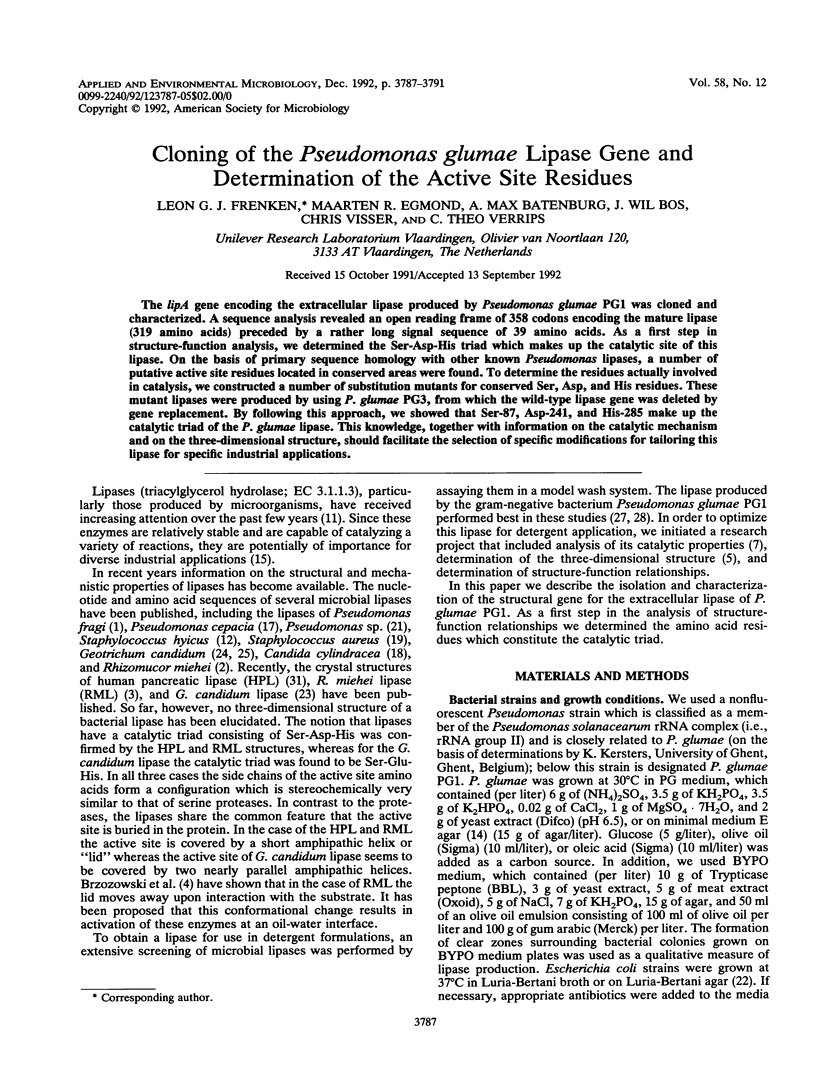
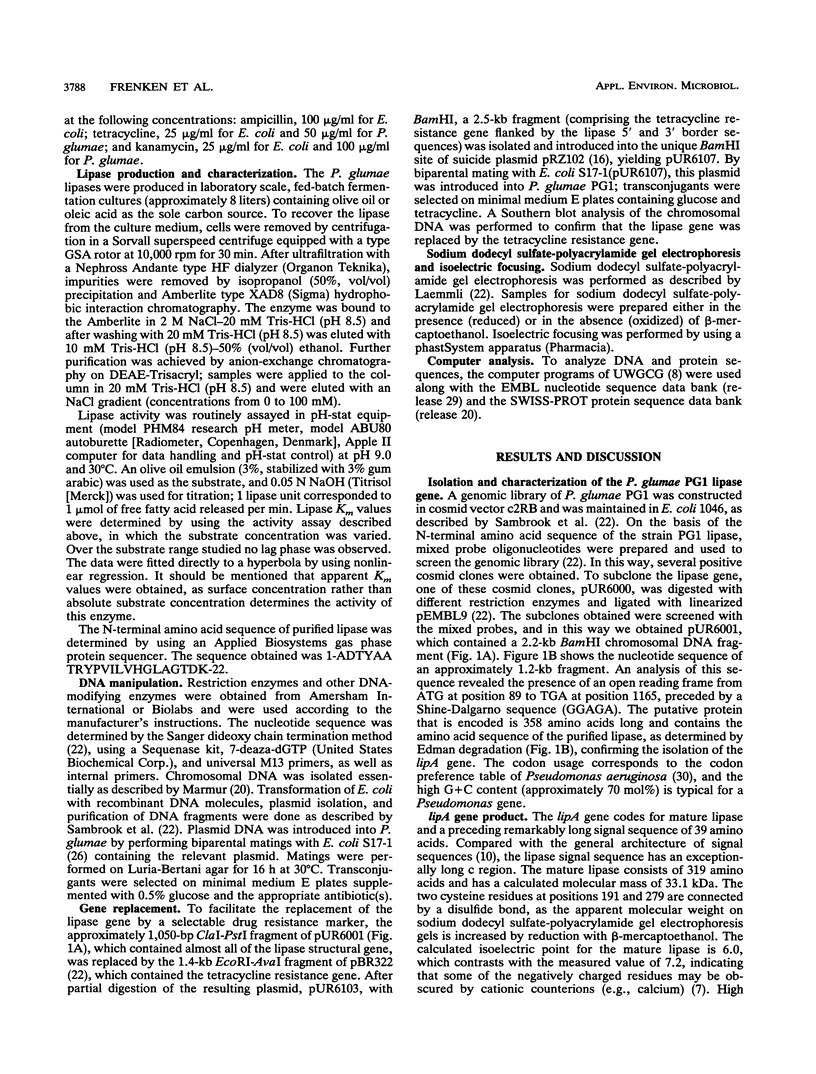
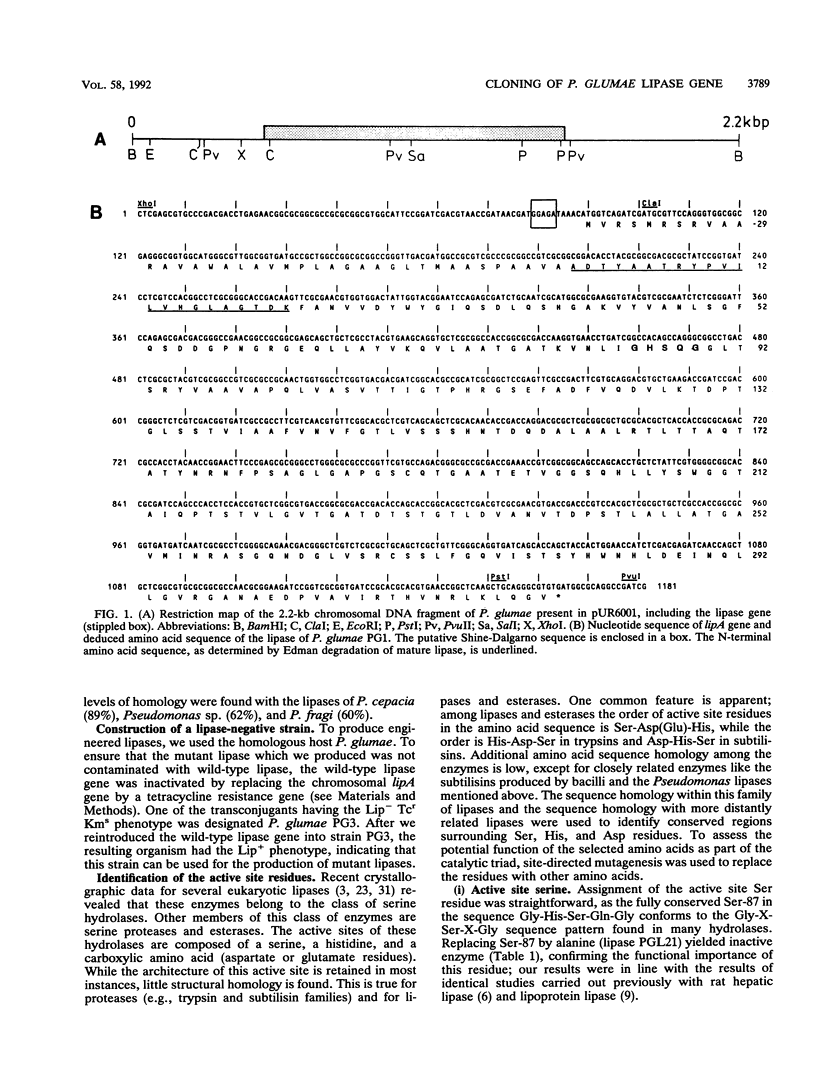
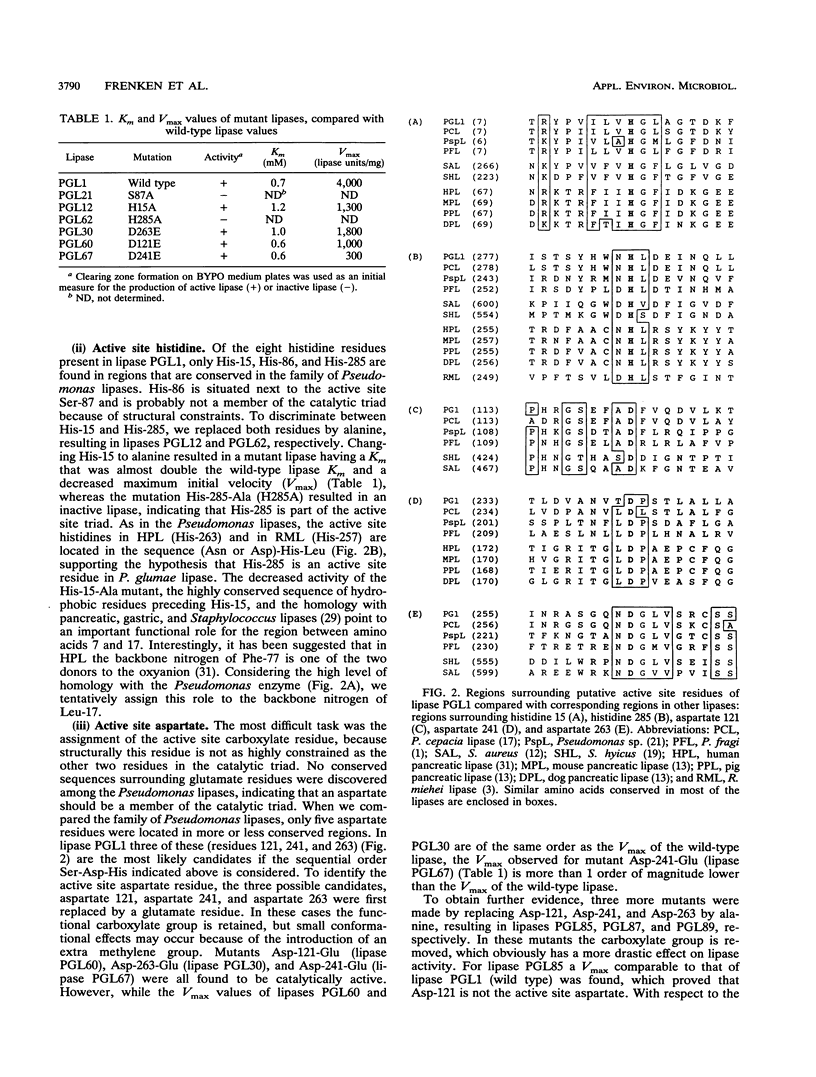
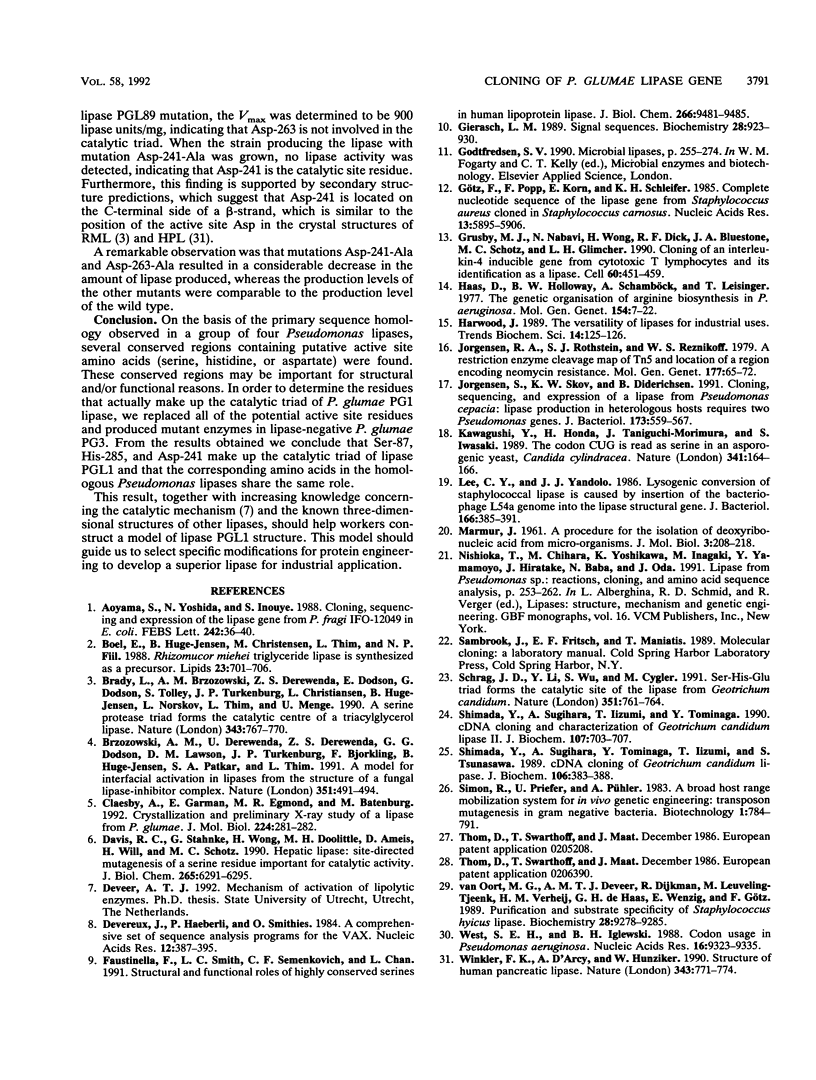
Selected References
These references are in PubMed. This may not be the complete list of references from this article.
- Aoyama S., Yoshida N., Inouye S. Cloning, sequencing and expression of the lipase gene from Pseudomonas fragi IFO-12049 in E. coli. FEBS Lett. 1988 Dec 19;242(1):36–40. doi: 10.1016/0014-5793(88)80980-3. [DOI] [PubMed] [Google Scholar]
- Boel E., Huge-Jensen B., Christensen M., Thim L., Fiil N. P. Rhizomucor miehei triglyceride lipase is synthesized as a precursor. Lipids. 1988 Jul;23(7):701–706. doi: 10.1007/BF02535672. [DOI] [PubMed] [Google Scholar]
- Brady L., Brzozowski A. M., Derewenda Z. S., Dodson E., Dodson G., Tolley S., Turkenburg J. P., Christiansen L., Huge-Jensen B., Norskov L. A serine protease triad forms the catalytic centre of a triacylglycerol lipase. Nature. 1990 Feb 22;343(6260):767–770. doi: 10.1038/343767a0. [DOI] [PubMed] [Google Scholar]
- Brzozowski A. M., Derewenda U., Derewenda Z. S., Dodson G. G., Lawson D. M., Turkenburg J. P., Bjorkling F., Huge-Jensen B., Patkar S. A., Thim L. A model for interfacial activation in lipases from the structure of a fungal lipase-inhibitor complex. Nature. 1991 Jun 6;351(6326):491–494. doi: 10.1038/351491a0. [DOI] [PubMed] [Google Scholar]
- Cleasby A., Garman E., Egmond M. R., Batenburg M. Crystallization and preliminary X-ray study of a lipase from Pseudomonas glumae. J Mol Biol. 1992 Mar 5;224(1):281–282. doi: 10.1016/0022-2836(92)90593-9. [DOI] [PubMed] [Google Scholar]
- Davis R. C., Stahnke G., Wong H., Doolittle M. H., Ameis D., Will H., Schotz M. C. Hepatic lipase: site-directed mutagenesis of a serine residue important for catalytic activity. J Biol Chem. 1990 Apr 15;265(11):6291–6295. [PubMed] [Google Scholar]
- Devereux J., Haeberli P., Smithies O. A comprehensive set of sequence analysis programs for the VAX. Nucleic Acids Res. 1984 Jan 11;12(1 Pt 1):387–395. doi: 10.1093/nar/12.1part1.387. [DOI] [PMC free article] [PubMed] [Google Scholar]
- Faustinella F., Smith L. C., Semenkovich C. F., Chan L. Structural and functional roles of highly conserved serines in human lipoprotein lipase. Evidence that serine 132 is essential for enzyme catalysis. J Biol Chem. 1991 May 25;266(15):9481–9485. [PubMed] [Google Scholar]
- Gierasch L. M. Signal sequences. Biochemistry. 1989 Feb 7;28(3):923–930. doi: 10.1021/bi00429a001. [DOI] [PubMed] [Google Scholar]
- Grusby M. J., Nabavi N., Wong H., Dick R. F., Bluestone J. A., Schotz M. C., Glimcher L. H. Cloning of an interleukin-4 inducible gene from cytotoxic T lymphocytes and its identification as a lipase. Cell. 1990 Feb 9;60(3):451–459. doi: 10.1016/0092-8674(90)90596-7. [DOI] [PubMed] [Google Scholar]
- Götz F., Popp F., Korn E., Schleifer K. H. Complete nucleotide sequence of the lipase gene from Staphylococcus hyicus cloned in Staphylococcus carnosus. Nucleic Acids Res. 1985 Aug 26;13(16):5895–5906. doi: 10.1093/nar/13.16.5895. [DOI] [PMC free article] [PubMed] [Google Scholar]
- Haas D., Holloway B. W., Schamböck A., Leisinger T. The genetic organization of arginine biosynthesis in Pseudomonas aeruginosa. Mol Gen Genet. 1977 Jul 7;154(1):7–22. doi: 10.1007/BF00265571. [DOI] [PubMed] [Google Scholar]
- Harwood J. The versatility of lipases for industrial uses. Trends Biochem Sci. 1989 Apr;14(4):125–126. doi: 10.1016/0968-0004(89)90140-0. [DOI] [PubMed] [Google Scholar]
- Jorgensen R. A., Rothstein S. J., Reznikoff W. S. A restriction enzyme cleavage map of Tn5 and location of a region encoding neomycin resistance. Mol Gen Genet. 1979;177(1):65–72. doi: 10.1007/BF00267254. [DOI] [PubMed] [Google Scholar]
- Jørgensen S., Skov K. W., Diderichsen B. Cloning, sequence, and expression of a lipase gene from Pseudomonas cepacia: lipase production in heterologous hosts requires two Pseudomonas genes. J Bacteriol. 1991 Jan;173(2):559–567. doi: 10.1128/jb.173.2.559-567.1991. [DOI] [PMC free article] [PubMed] [Google Scholar]
- Kawaguchi Y., Honda H., Taniguchi-Morimura J., Iwasaki S. The codon CUG is read as serine in an asporogenic yeast Candida cylindracea. Nature. 1989 Sep 14;341(6238):164–166. doi: 10.1038/341164a0. [DOI] [PubMed] [Google Scholar]
- Lee C. Y., Iandolo J. J. Lysogenic conversion of staphylococcal lipase is caused by insertion of the bacteriophage L54a genome into the lipase structural gene. J Bacteriol. 1986 May;166(2):385–391. doi: 10.1128/jb.166.2.385-391.1986. [DOI] [PMC free article] [PubMed] [Google Scholar]
- Schrag J. D., Li Y. G., Wu S., Cygler M. Ser-His-Glu triad forms the catalytic site of the lipase from Geotrichum candidum. Nature. 1991 Jun 27;351(6329):761–764. doi: 10.1038/351761a0. [DOI] [PubMed] [Google Scholar]
- Shimada Y., Sugihara A., Iizumi T., Tominaga Y. cDNA cloning and characterization of Geotrichum candidum lipase II. J Biochem. 1990 May;107(5):703–707. doi: 10.1093/oxfordjournals.jbchem.a123112. [DOI] [PubMed] [Google Scholar]
- Shimada Y., Sugihara A., Tominaga Y., Iizumi T., Tsunasawa S. cDNA molecular cloning of Geotrichum candidum lipase. J Biochem. 1989 Sep;106(3):383–388. doi: 10.1093/oxfordjournals.jbchem.a122862. [DOI] [PubMed] [Google Scholar]
- West S. E., Iglewski B. H. Codon usage in Pseudomonas aeruginosa. Nucleic Acids Res. 1988 Oct 11;16(19):9323–9335. doi: 10.1093/nar/16.19.9323. [DOI] [PMC free article] [PubMed] [Google Scholar]
- Winkler F. K., D'Arcy A., Hunziker W. Structure of human pancreatic lipase. Nature. 1990 Feb 22;343(6260):771–774. doi: 10.1038/343771a0. [DOI] [PubMed] [Google Scholar]
- van Oort M. G., Deveer A. M., Dijkman R., Tjeenk M. L., Verheij H. M., de Haas G. H., Wenzig E., Götz F. Purification and substrate specificity of Staphylococcus hyicus lipase. Biochemistry. 1989 Nov 28;28(24):9278–9285. doi: 10.1021/bi00450a007. [DOI] [PubMed] [Google Scholar]


